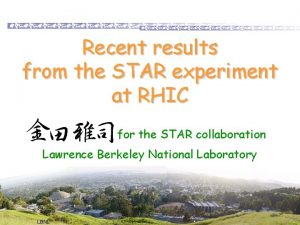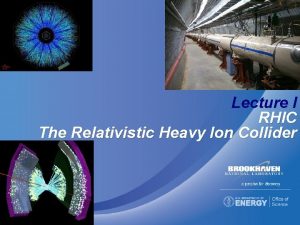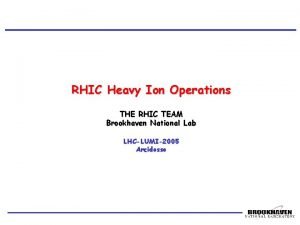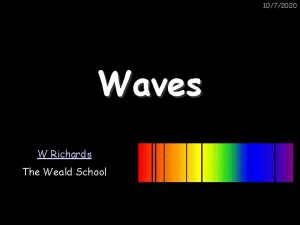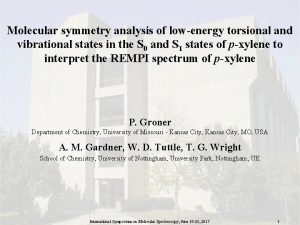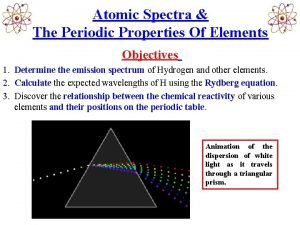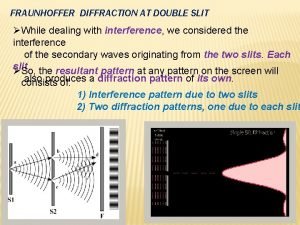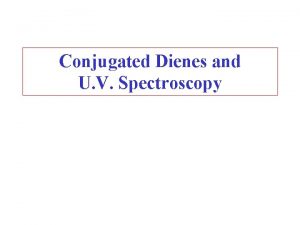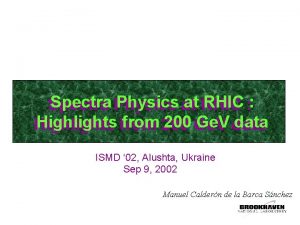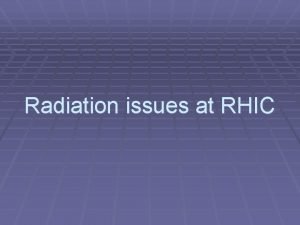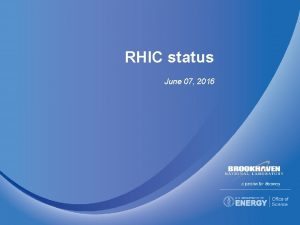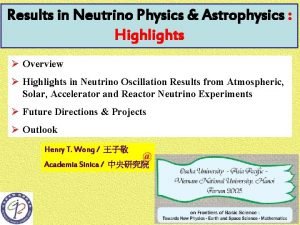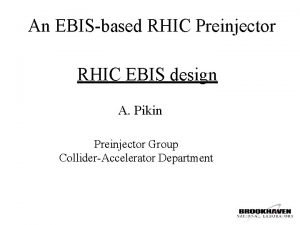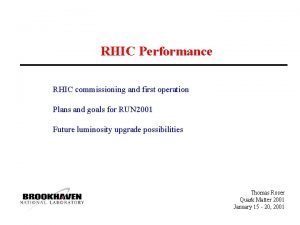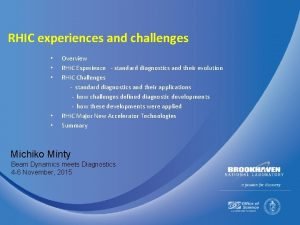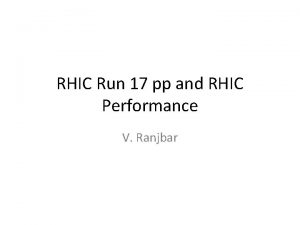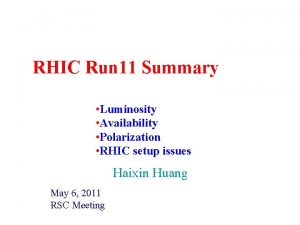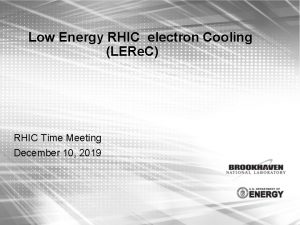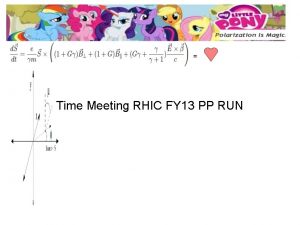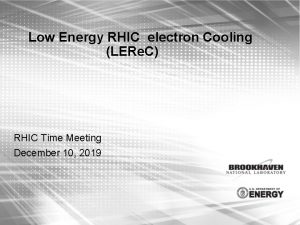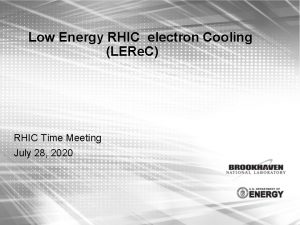Spectra Physics at at RHIC Spectra Highlights from


















- Slides: 18

Spectra Physics at at RHIC : : Spectra Highlights from 200 Ge. V data Highlights ISMD ‘ 02, Alushta, Ukraine Sep 9, 2002 Manuel Calderón de la Barca Sánchez

Understanding “Bulk” Matter in HI collisions Studying Matter: Global Observables Nch, ET , p. T e, S, … u 99. 5% Particle Yields & Ratios Tch, m. B, m. S, … u Particle Spectra Tfo, flow, stopping, … u STAR preliminary 2

Nch: Centrality Dependence at RHIC (SPS) PHOBOS Au+Au |h|<1 200 Ge. V 130 Ge. V _ pp Au+Au 19. 6 Ge. V (preliminary) preliminary Everything counts: • Nch|h=0 described nicely by Kharzeev-Nardi (hard + soft) • Nch scales with Npart 3

ET / Nch from SPS to RHIC PHENIX preliminary Independent of centrality PHENIX preliminary Independent of energy Surprising fact: SPS RHIC: increased flow, all particles higher p. T still ET / Nch changes very little Does different composition (chemistry) account for that? 4

p. T of Charged Hadrons from SPS to RHIC increase only ~2% STAR preliminary Saturation model: J. Schaffner-Bielich, et al. nucl-th/0108048 D. Kharzeev, et al. hep-ph/0111315 Many models predict similar scaling (incl. hydro) Need data around s = 70 Ge. V to verify (or falsify) 5

Ratios Huge amount of results from all 4 RHIC experiments: • systematic studies of: -/ +, K-/K+, p/p, / , /p, K/ , /h, , , f K, K*/K, … u many as function of p. T, Npart u at s of (20), 130, and 200 Ge. V u Problem: with and without feed-down correction BRAHMS large y coverage and reach to high p. T PHENIX reach to high p. T STAR multi-strange baryons 6

Ratios at RHIC I : vs. p^ All experiments: - + 1 K-/K+ 0. 95 Does p/p also stay constant, or does it begin falling? 7

Ratios at RHIC II: vs. y BRAHMS 200 Ge. V At mid-rapidity: Net-protons: d. N/dy 7 proton yield: d. N/dy 29 ¾ of all protons from pair-production 8

K-/K+ and p/p from AGS to RHIC Slightly different view of statistical model. Becattini calculation using statistical model: T=170, gs=1 (weak dependency) vary m. B/T K+/K- and p/p K- /K+=( p/p)1/4 is a empirical fit to the data points K- K+ driven by ms ~ exp(2 ms/T) p/p driven by m. B ~ exp(-2 m. B/T) ms = ms (m. B) since <S> = 0 BUT: Holds for y 0 (BRAHMS y=3) 9

Rapidity Spectra: Boost-Invariance at RHIC ? D. Ouerdane (BRAHMS) 10

Boost-Invariance at RHIC ? - - • d. N/dy of pions looks boost-invariant BUT • change in slopes for rapidity already from 0 1 • BRAHMS (J. H. Lee): no change in proton slope from y = 0 3 BUT increase in d. N/dy Boost invariance only achieved in small region |y|<0. 5 11

Identified Particle Spectra at RHIC @ 200 Ge. V BRAHMS: 10% central PHOBOS: 15% PHENIX: 5% STAR: 5% Feed-down matters !!! 12

Interpreting the Spectra The shape of the various particle spectra teach us about: u Kinetic freeze-out temperatures u Transverse flow The stronger the flow the less appropriate are simple exponential fits: u Hydrodynamic models (a la Heinz/Kolb/Shuryak/Huovinen/Teaney) u Hydro inspired parameterizations (Blastwave) Blastwave parameterization: u u Ref. : E. Schnedermann et al, PRC 48 (1993) 2462 (modifications by Snellings, Voloshin) spectra ( ) Very successful in recent months l l l Spectra HBT (incl. the Rout/Rside puzzle) Flow HBT b 13

Blastwave Fits at 130 & 200 Ge. V Results depend slightly on p. T coverage 200 Ge. V STAR: Tfo ~ 100 Me. V b. T ~ 0. 55 c (130) & 0. 6 c (200) PHENIX: Tfo ~ 110 Me. V (200) b. T ~ 0. 5 c (200) Fits M. Kaneta (STAR) 14

What flows and when? STAR preliminary F. Wang <p. T> prediction with Tth and <b> obtained from blastwave fit (green line) <p. T> prediction for Tch = 170 Me. V and <b>=0 pp no rescattering, no flow no thermal equilibrium and appear to deviate from common thermal freeze-out Smaller elast? Early decoupling from expanding hadronic medium? Less flow? What about partonic flow? 15

Does it flow? Fits to Omega m. T spectra STAR preliminary RHIC SPS/NA 49 b. T is not well constrained ! • What do we now about elast of and ? • May be it flows, and may be they freeze out with the others • Maybe and are consistent with a blastwave fit at RHIC • Need to constrain further more data & much more for v 2 of 16

Other Attempts: The Single Freeze-Out Model Single freeze-out model (Tch=Tfo) (W. Broniowski et. al) fit the data well (and reproduce f, K*, , , ) Thermal fits to spectra are not enough to make the point. To discriminate between different models they have to prove their validity by describing: u Spectra (shape & yield) u Correlations (HBT, balance function, etc. ) u Flow Only then we can learn … 17

Conclusions • Flood of data from SPS & RHIC u new probes u correlations between probes u higher statistics & precision • Models (Generators) are behind u The majority of models in RHI fail already describing global observables (possible exception AMPT) u Many models describe “A” well but fail badly at “B” can still be useful but limited scope l We learn more by combing various pieces and putting them into context § Thermalization, Chemical and Kinetic Freeze-out Conditions, and System Dynamics can only be studied (and are studied) using all the pieces together u Agreement between thermal fits to particle spectra and ratios + flow makes a very strong case for thermalization of matter created at RHIC 18
 Rhic
Rhic Orbital revolution
Orbital revolution Rhic brookhaven
Rhic brookhaven Rhic ags users meeting 2020
Rhic ags users meeting 2020 Drawing a face highlights what principle of design
Drawing a face highlights what principle of design Proposal highlights
Proposal highlights Highlights from the book of isaiah
Highlights from the book of isaiah Highlights memorandum
Highlights memorandum Weekly diary for work immersion
Weekly diary for work immersion Investment highlights
Investment highlights The passage highlights……
The passage highlights…… Key highlights
Key highlights Highlights from the book of isaiah
Highlights from the book of isaiah Weald to waves
Weald to waves Vibronic spectra
Vibronic spectra Periodic table of spectra
Periodic table of spectra Fraunhoffer diffraction
Fraunhoffer diffraction Potassium lithium
Potassium lithium Double bond extending conjugation
Double bond extending conjugation
